
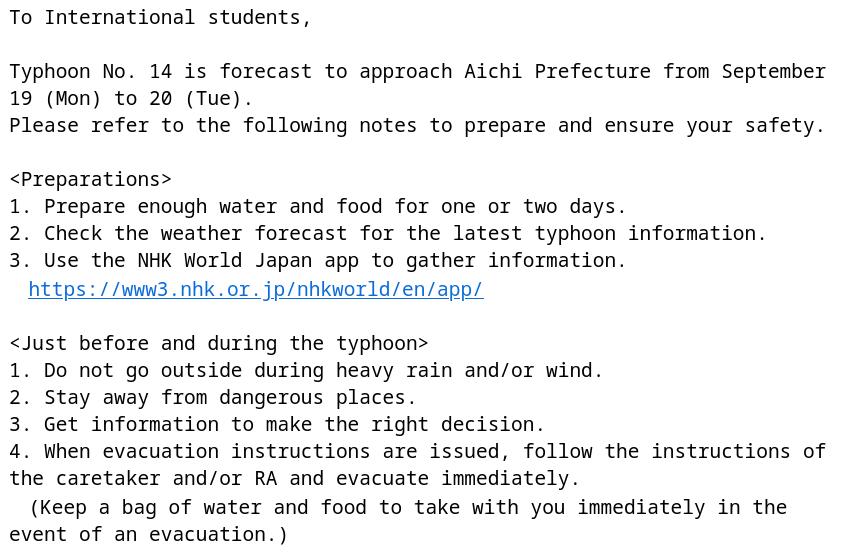
I spent autumn and winter 2022 in Japan as an exchange student, namely in Nagoya at the NUFS (Nagoya University of Foreign Studies). Arrival was on August 24th and departure is planned for December 23rd, so four months in total.
The current plan is to shove everything which does not deserve a
whole new page into this document put some stuff on this page and
some on dedicated ones, meaning a time-based index becomes necessary.
Please enjoy easiness of navigation made possible through the power of
hypertext.
August and September in Japan is typhoon season which is why it’s important to regularly check the news and pay attention to warnings. Typhoons in Japan are numbered instead of named, and the numbering resets every year. Since I came here, there have been three typhoons which mostly missed us and stayed on the ocean or hit South Korea, but an emergency warning has been issued for the super typhoon Nanmadol (No. 14). I received a push notification from the NHK app as well as several mails from the university yesterday urging us to prepare enough food and water and to not leave the dorm on monday as the typhoon is expected to reach us by then.


Classes on monday are held online. I still need to buy supplies which I’ll do tomorrow morning, but I don’t think anything will happen as the cyclone is predicted to make landfall at Kagoshima and get weaker afterwards. People in the Kyuushuu area will have a tough time though as the storm will make landfall with full force. Evacuation orders have been issued for some regions already and flights are being cancelled.
There’s a cafe in our area called and cafe. It has a kind of pub-like atmosphere and, though quite expensive, has a variety of different drinks and food.
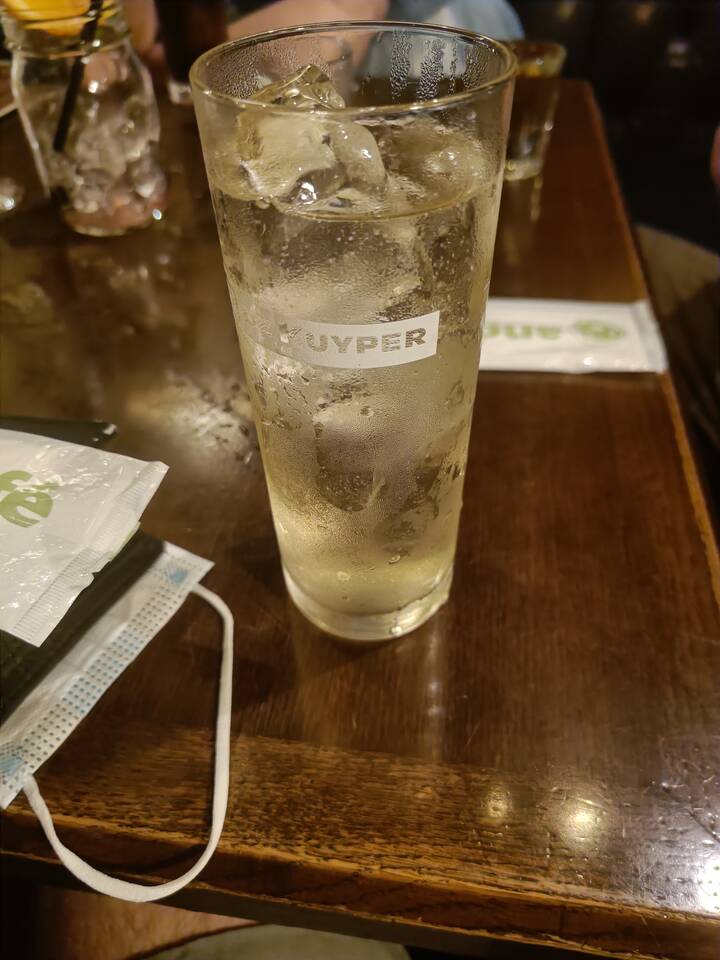





We went as a group of 31 to JoyJoy karaoke at Fujigaoka station. The entrance fee was 1500 yen and we split our group into two, each going to a different room. To my surprise, drinks (even alcoholic cocktails!) were completely free, you could just walk up to the bar and order what you wanted. I of course couldn’t let this opportunity slip and got right down to ordering.
I’ve never been to karaoke before so I was kinda anxious whether my (non-existent) singing skills were good enough - but it didn’t matter at all. We sang every kind of song imaginable for two hours and with a group of 15 people, the atmosphere was perfect. 9/10 would do again.
Oh lord, two more days to go! Although receiving the visa was the last major step regarding organization, there was still a lot of preparation to be done.
Probably the most important thing to consider is how to get to that sweet sweet money you need for your daily expenses. Japan is still a cash-based society so you need to be able to withdraw cash. Fortunately, every 7-11 convenience store has an ATM run by SevenBank which you can use to withdraw cash. I only had a debit card until this point so I went to my bank and asked them for a credit card. I also learned that my debit card is Maestro-capable which means I can use it globally as a MasterCard. I now have two cards which should both work, but I’m probably gonna use my Maestro card since the MasterCard has horrendous fees of like 5%.
I also bought some new electronics in the form of a tablet and noise-cancelling headphones to use on the flight. In addition, I will bring my old headphones as a backup in case something goes wrong as I can’t live without music.
I will also bring my laptop of course and try to kill some time doing programming challenges or learning new stuff. I’m also gonna make use of the nice torrent helper I’ve written a couple of days ago to download an ungodly amount of anime. Thirteen hours is not that terrible, but I guess having something to do is still nice.
Aside from money and electronics, I also bought daily necessities like new clothing, shampoo and toothpaste. A new suitcase was also necessary. The airline limits total weight to 23kg and inner dimensions to something like 158cm, so be careful to not exceed this limit. I’m planning to pack lightly anyway as I’ll be doing laundry each week and want to take lots of stuff from Japan back home!
Japan at the current point of time is still closed to foreign tourism due to the ongoing pandemic. Fortunately, it reopened a few months ago to international students which was great news for me! Despite reopening the borders, there are still lots of strict measures in place which basically means you need to do a shit ton of stuff to be able to enter.
First of all, you need to be tested negatively for Covid at most 72h before the flight. I depart on tuesday which means I need to get tested on monday. The Japanese government has given out a form which needs to be filled out by the testing institution to confirm stuff like exact testing method used and so on. You also need a Covid vaccination certificate which most people probably already have. In my case, a scan of the EU one was enough.
Although these documents can be submitted in paper-form at the arrival airport, it could take some time for the staff to confirm so there are pre-departure processes in place, namely Fast Track and Visit Japan Web. Fast Track works downloading the MySOS app and completing four steps:
I have completed the first three steps and they were already positively confirmed by the app. The app background currently is yellow, but it’s supposed to turn green once I submit my negative covid test. I am then able to show the green screen to staff at the airport without any additional questioning.
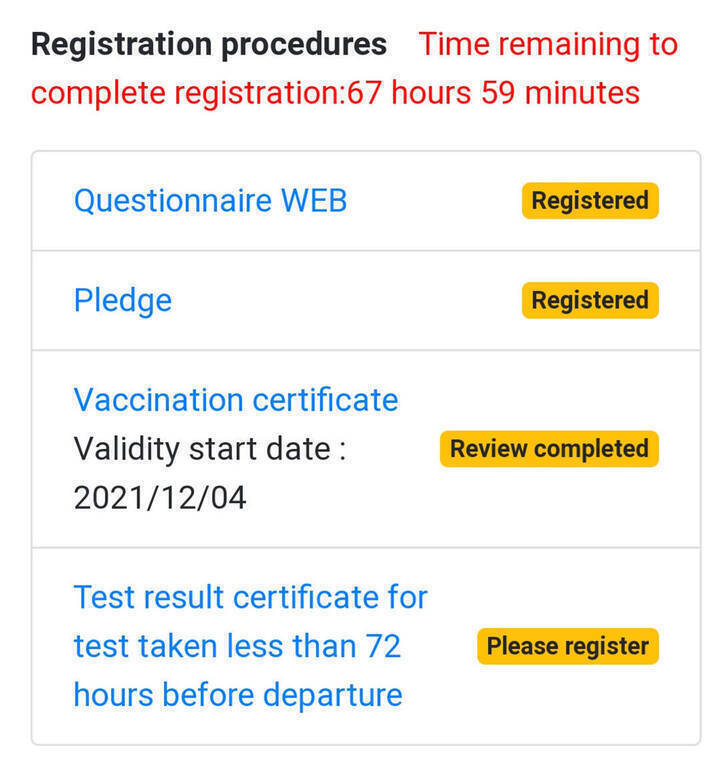
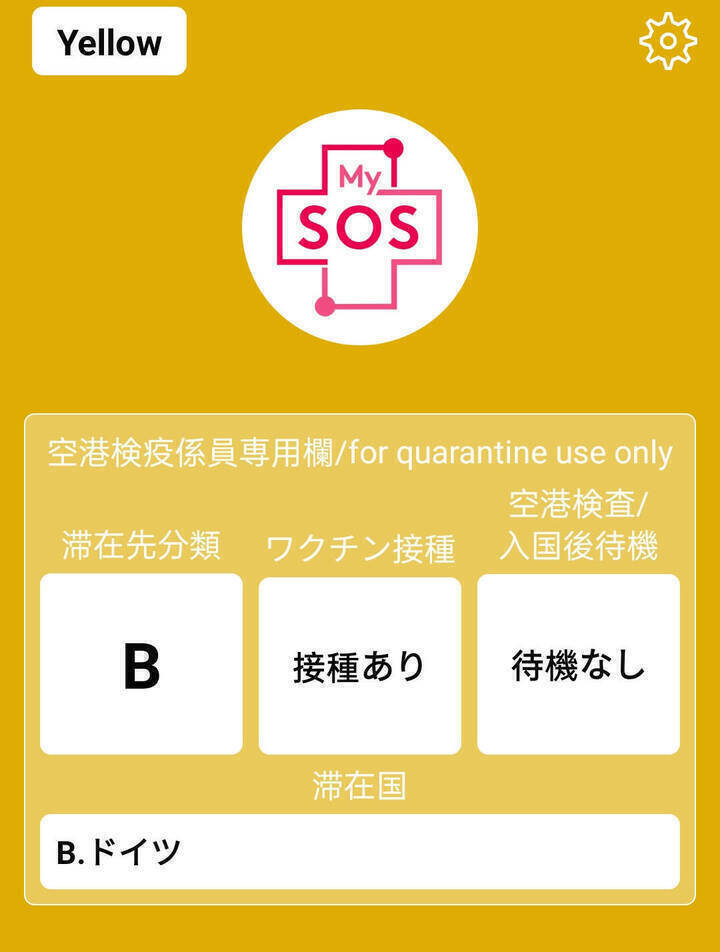
MySOS was working fairly well for a government-issued app, but it still suffered from long loading times which took place in the foreground, blocking off all other activity. And while the app itself could be set to English, the sites it redirected to stayed in Japanese, at least for me. I still managed to figure everything out somehow, but other people might have been in trouble. So much for app design, but it works, so eh.
Visit Japan Web basically needs the same information, but is used to preregister for immigration procedures instead. It can also be used to declare customs, but that doesn’t apply to me. I’ve yet to fill it out, but it’ll hopefully be just as smooth as the Fast Track experience.
If you want to stay for more than 90 days in Japan you need a visa, in my case the General Visa: Student. Once I received all necessary documents, I immediately filled out the visa application form and took the first train on the next day to the Japanese consulate in Frankfurt. I missed it at first because it is located in the 34th floor of the Messe Turm, but the reception staff kindly showed me the way. After a short security check, I submitted all documents to the staff - and was told the back side of the CoE was missing. I was confused at first because I didn’t receive any more documents, but after sending a mail to NUFS and explaining the situation (which surprised them too by the way), they sent the back side as well which allowed me to finally submit my application.
I needed to submit the following documents:
A few days after submission I noticed a mistake from my side. I had stated Centrair as the port of entry as I assumed I would only land in Haneda for transit and wouldn’t pass through immigration, which apparently was wrong. After panicking, I sent a mail to the consulate explaining the situation and they told me everything is fine and I can just correct it when picking up the visa which I finally did.
Picking the visa up was easy as I just had to show them my personal ID card and after around half an hour I received my passport back and the process was finished!
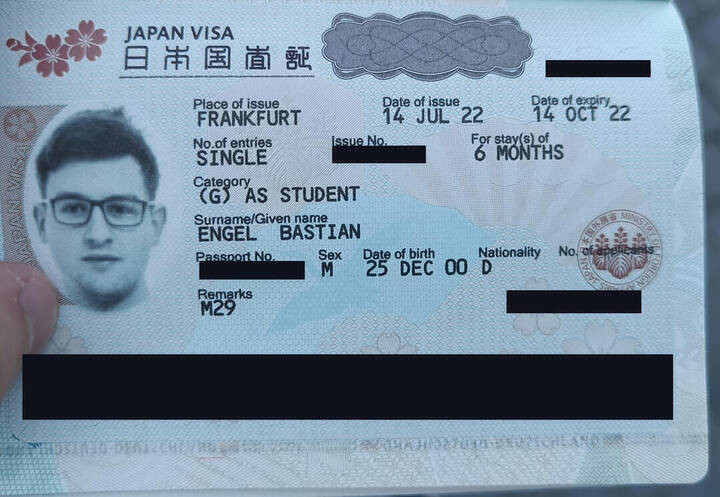
You should probably book your flight later than I did, at least if Covid is still a thing. The visa only allows you to enter Japan on one predetermined day and if rules change and you need to quarantine you have to reschedule your flight or book a new one which could potentially become very expensive. The booking process itself was really easy, I just called a travel agency and they made an offer. I paid around 1200 Euros for a round trip ticket with a direct connection from Frankfurt to Tōkyō and Tōkyō to Nagoya and a total flight time of around 15 hours, not including transit.
Mobility-Online is the online application tool aiding you in your application process. There are lots of steps necessary to complete the application which are nicely summarized by Mobility-Online. You submit your documents there and wait for the international office to accept them and redirect your application to the partner university.
Mobility-Online is great, but is only the first part of the application process. After you’re nominated at the partner university, they require tons of documents as well which I managed to submit through a lively mail exchange.
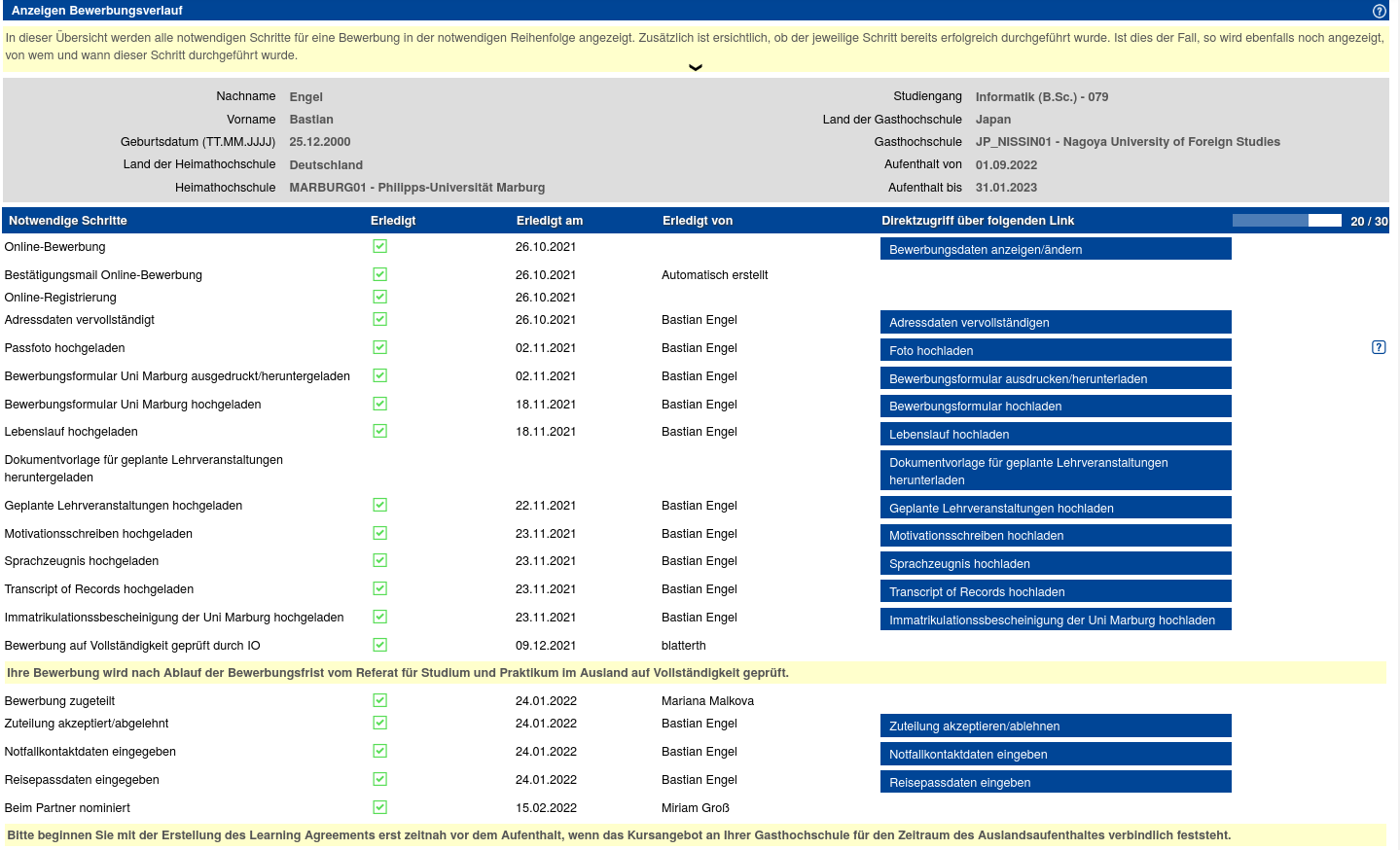
You should reach out to the international office as soon as possible and clearly communicate what you want to do. Knowing early what you need to submit and when you need to submit it and already knowing the people working there helps greatly.
You probably want to spend some time researching your potential partner universities and reducing the number of candidates. Choosing to begin organizing your semester abroad early will also help to keep your mind at ease knowing exactly what needs to be done next and when you need to finish it. In my case, I spent the months between the first contact and submission of my application to take a look at the programs offered by university candidates and comparing things like the living situation and extracurricular activities. More often than not you need a large enough time buffer to acquire certain documents, e.g. an English language certification.
You also shouldn’t refrain from contacting people when you’re stuck or have questions. After all, organization lies in your hands and demands a certain level of initiative.